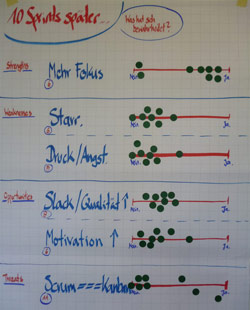Have you ever used the SWOT Matrix? Did the results bring about a decision? And then? Have you used the results after some time to validate your decision again? This post describes how I used a SWOT Matrix to help a team to try working with Scrum. After 4 months we validated what we thought then defined as strength, weakness, opportunity or threat.
A “SWOT analysis (alternatively SWOT Matrix) is a structured planning method used to evaluate the Strengths, Weaknesses, Opportunities, and Threats involved in a project or in a business venture.”
Prepare a four-square quadrant using 4 or one huge flip-charts. Each quadrant is named one of the following words: Strengths, Weaknesses, Opportunities, Threats.
 Strengths: characteristics of the business or project that give it an advantage over others
Strengths: characteristics of the business or project that give it an advantage over others
Weaknesses: are characteristics that place the team at a disadvantage relative to others
Opportunities: elements that the project could exploit to its advantage
Threats: elements in the environment that could cause trouble for the business or project
(Source: Wikipedia)
I asked the team to write on post-its what the strengths, weaknesses, opportunities or threats are if we try working with Scrum for 3 months. After everyone had finished writing, explaining and sticking their post-its, we simply clustered the post-its and then dot voted the cluster (“What are the most relevant cluster for that quadrant?”).

By now the SWOT Matrix helped the team already to identify and address all factors related to the change (“Try working with Scrum”), both positive and negative. It also helped team members to understand that they are not the only ones who see a threat or an opportunity. Or the other way around: Team members understand that their identified weakness of the change might as well be ruled out by several strengths of other team members.
Having identified all the factors with the SWOT Matrix I pushed them in a direction with the final question: “How high is your resistance to try working with Scrum for 3 months?” (I made some good experiences in the last months with avoiding “Yes-No-Decisions” but rather to start an experiment with asking about the resistance to something and then try to reach an agreement.) As the resistance to try it was rather low, we worked with Scrum in the last 4 months.

This week we validated our decision to work with Scrum and as well checked which of the assumed strengths, weaknesses, opportunities or threats really came true.
It was great to review the dot voted clusters from 4 months ago and then validate if those have proved true. For this purpose I simply prepared a flip chart with a range from “yes” to “no” next to the names of the cluster and asked for each “After 10 Sprints: What has proved to be true?”
As a result we had a good discussion about the clusters that didn’t turn out to be true and what to do about it. (Could be a nice topic for a post as well. :)) Again we finished the meeting with asking about the resistance to keep on using Scrum. As you can see: There is hardly any resistance.
